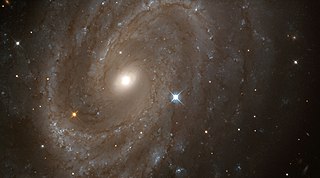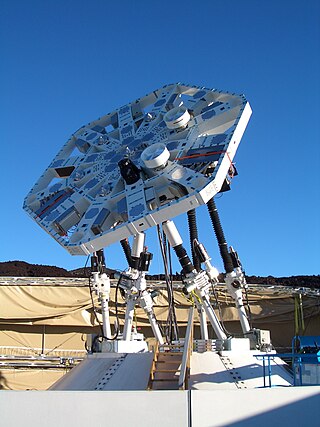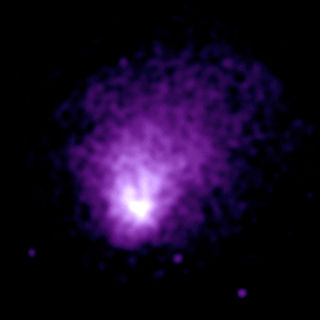Related Research Articles

Galaxy groups and clusters are the largest known gravitationally bound objects to have arisen thus far in the process of cosmic structure formation. They form the densest part of the large-scale structure of the Universe. In models for the gravitational formation of structure with cold dark matter, the smallest structures collapse first and eventually build the largest structures, clusters of galaxies. Clusters are then formed relatively recently between 10 billion years ago and now. Groups and clusters may contain ten to thousands of individual galaxies. The clusters themselves are often associated with larger, non-gravitationally bound, groups called superclusters.
The Sunyaev–Zeldovich effect is the spectral distortion of the cosmic microwave background (CMB) through inverse Compton scattering by high-energy electrons in galaxy clusters, in which the low-energy CMB photons receive an average energy boost during collision with the high-energy cluster electrons. Observed distortions of the cosmic microwave background spectrum are used to detect the disturbance of density in the universe. Using the Sunyaev–Zeldovich effect, dense clusters of galaxies have been observed.

The South Pole Telescope (SPT) is a 10-metre (390 in) diameter telescope located at the Amundsen–Scott South Pole Station, Antarctica. The telescope is designed for observations in the microwave, millimeter-wave, and submillimeter-wave regions of the electromagnetic spectrum, with the particular design goal of measuring the faint, diffuse emission from the cosmic microwave background (CMB). The first major survey with the SPT—designed to find distant, massive, clusters of galaxies through their interaction with the CMB, with the goal of constraining the dark energy equation of state—was completed in October 2011. In early 2012, a new camera (SPTpol) was installed on the SPT with even greater sensitivity and the capability to measure the polarization of incoming light. This camera operated from 2012–2016 and was used to make unprecedentedly deep high-resolution maps of hundreds of square degrees of the Southern sky. In 2017, the third-generation camera SPT-3G was installed on the telescope, providing nearly an order-of-magnitude increase in mapping speed over SPTpol.

The Atacama Cosmology Telescope (ACT) was a cosmological millimeter-wave telescope located on Cerro Toco in the Atacama Desert in the north of Chile. ACT made high-sensitivity, arcminute resolution, microwave-wavelength surveys of the sky in order to study the cosmic microwave background radiation (CMB), the relic radiation left by the Big Bang process. Located 40 km from San Pedro de Atacama, at an altitude of 5,190 metres (17,030 ft), it was one of the highest ground-based telescopes in the world.
In astronomy, the intracluster medium (ICM) is the superheated plasma that permeates a galaxy cluster. The gas consists mainly of ionized hydrogen and helium and accounts for most of the baryonic material in galaxy clusters. The ICM is heated to temperatures on the order of 10 to 100 megakelvins, emitting strong X-ray radiation.

NGC 4603 is a spiral galaxy located about 107 million light years away in the constellation Centaurus. It is a member of the Centaurus Cluster of galaxies, belonging to the section designated "Cen30". The morphological classification is SA(s)c, which indicates it is a pure spiral galaxy with relatively loosely wound arms.
A color–color diagram is a means of comparing the colors of an astronomical object at different wavelengths. Astronomers typically observe at narrow bands around certain wavelengths, and objects observed will have different brightnesses in each band. The difference in brightness between two bands is referred to as color. On color–color diagrams, the color defined by two wavelength bands is plotted on the horizontal axis, and the color defined by another brightness difference will be plotted on the vertical axis.

Abell 520 is a galaxy cluster in the Orion constellation, located at a co-moving radial distance of 811 Mpc (2,645 Mly) and subtends 25 arcminutes on the Earth sky.

NGC 4323 is a lenticular or dwarf elliptical galaxy located about 52.5 million light-years away in the constellation Coma Berenices. The galaxy was discovered in 1882 by astronomer Wilhelm Tempel and is a member of the Virgo Cluster.
Segue 1 is a dwarf spheroidal galaxy or globular cluster situated in the Leo constellation and discovered in 2006 by Sloan Digital Sky Survey. It is located at a distance of about 23 kpc from the Sun and moves away from the Sun with the velocity of about 206 km/s. Segue 1 has a noticeably elongated shape with the half-light radius of about 30 pc. This elongation may be caused by the tidal forces acting from the Milky Way galaxy if Segue 1 is being tidally disrupted now.

The Yuan-Tseh Lee Array for Microwave Background Anisotropy, also known as the Array for Microwave Background Anisotropy (AMiBA), is a radio telescope designed to observe the cosmic microwave background and the Sunyaev-Zel'dovich effect in clusters of galaxies.
SPT-CLJ2106-5844 is a galaxy cluster located 7.5 billion light years from Earth. It was discovered by scientists from the South Pole Telescope Collaboration, using the South Pole Telescope. With a weight of about 1.27 × 1015 solar masses, it is the most massive distant object known, as of 2011. It is about 60% heavier than previously known object detected in 2008, SPT-CL J0546-5345.

Hyper-Luminous X-ray source 1, commonly known as HLX-1, is an intermediate-mass black hole candidate located in the lenticular galaxy ESO 243-49 about 290 million light-years from Earth. The source was discovered at the Institut de Recherche en Astrophysique et Planétologie, Toulouse, France and gained interest from the scientific community because of strong evidence supporting it as an intermediate-mass black hole. HLX-1 is possibly the remnant of a dwarf galaxy that may have been in a galactic collision with ESO 243-49.

Abell 665 is a galaxy cluster in the Abell catalogue in the constellation Ursa Major. It is also known as the only cluster in his 1989 catalog to receive Abell's highest richness class of 5. This means that it contains at least 300 galaxies in the magnitude range of m3 to m3+2, where m3 is the magnitude of the third-brightest member of the cluster. The clusters in all other richness classes contain less than 300 such galaxies. Abell 665's combination of high brightness and large distance, made it an excellent candidate along with 37 other clusters to help determine the Hubble constant using the Sunyaev–Zel'dovich effect in 2006.

The Phoenix Cluster is a massive, Abell class type I galaxy cluster located at its namesake, southern constellation of Phoenix. It was initially detected in 2010 during a 2,500 square degree survey of the southern sky using the Sunyaev–Zel'dovich effect by the South Pole Telescope collaboration. It is one of the most massive galaxy clusters known, with the mass on the order of 2×1015M☉, and is the most luminous X-ray cluster discovered, producing more X-rays than any other known massive cluster. It is located at a comoving distance of 8.57 billion light-years from Earth. About 42 member galaxies were identified and currently listed in the SIMBAD Astronomical Database, though the real number may be as high as 1,000.

RX J1347.5–1145 is one of the most massive galaxy clusters known discovered in X-rays with ROSAT. As a result, it is also one of the most X-ray-luminous because of its hot gas content. The object resides roughly 5 billion light-years away from the Solar System in the constellation of Virgo. Redshift was noted as z=0.451 with an X-ray luminosity of 1045 ergs s−1 in a paper from 2002. In 2013, one study found eight cases of the same object resulting from the intense gravitational bending of light, which makes it possible to identify a series of remote galaxies located inside the galaxy cluster with calculations from the photometric method between 5.5 and 7.5. That study made use of data from Cluster Lensing and Supernova survey with Hubble (CLASH) as well as other sources. The colors in the galaxy cluster are known to correspond with the level of brightness, or the number of electrons trapped in the examined wavelength range of the cluster, with the colors red, orange, and yellow as high intensity, blue-green and green as medium intensity, and blue and violet as low intensity. It is considered one of the brightest objects that is known by X-ray.
The Etherington's distance-duality equation is the relationship between the luminosity distance of standard candles and the angular diameter distance. The equation is as follows: , where is the redshift, is the luminosity distance and the angular-diameter distance.
In cosmology, the missing baryon problem is an observed discrepancy between the amount of baryonic matter detected from shortly after the Big Bang and from more recent epochs. Observations of the cosmic microwave background and Big Bang nucleosynthesis studies have set constraints on the abundance of baryons in the early universe, finding that baryonic matter accounts for approximately 4.8% of the energy contents of the Universe. At the same time, a census of baryons in the recent observable universe has found that observed baryonic matter accounts for less than half of that amount. This discrepancy is commonly known as the missing baryon problem. The missing baryon problem is different from the dark matter problem, which is non-baryonic in nature.

Oliver Zahn is US/German theoretical astrophysicist, data scientist, and entrepreneur, best known for developing algorithms for astrophysical data analysis and widely cited discoveries of phenomena in the history of the Universe. He is also known for his more recent work as founder and CEO of Climax Foods, a California-based biotechnology company modeling dairy and other animal products directly from plant ingredients. Prior to becoming an entrepreneur, Zahn directed UC Berkeley's Center for Cosmological Physics alongside George Smoot and Saul Perlmutter and was Head of Data Science at Google
Viviana Acquaviva is an Italian astrophysicist who is a professor in the Department of Physics at the New York City College of Technology. Her research interests consider data science and machine learning for physics and astronomy. She was named one of Italy's most inspirational technologists in 2019.
References
- ↑ M. Brodwin; et al. (2010). "SPT-CL J0546-5345: A Massive z>1 Galaxy Cluster Selected Via the Sunyaev-Zel'dovich Effect with the South Pole Telescope". The Astrophysical Journal. 721 (1): 90–97. arXiv: 1006.5639 . Bibcode:2010ApJ...721...90B. doi:10.1088/0004-637X/721/1/90. S2CID 54988474.
- ↑ K. Vanderlinde; et al. (2010). "Galaxy Clusters Selected with the Sunyaev-Zel'dovich Effect from 2008 South Pole Telescope Observations". The Astrophysical Journal. 722 (2): 1180–1196. arXiv: 1003.0003 . Bibcode:2010ApJ...722.1180V. doi:10.1088/0004-637X/722/2/1180. S2CID 119206180.
- ↑ F. W. High; et al. (2010). "Optical Redshift and Richness Estimates for Galaxy Clusters Selected with the Sunyaev-Zel'dovich Effect from 2008 South Pole Telescope Observations". The Astrophysical Journal. 723 (2): 1736–1747. arXiv: 1003.0005 . Bibcode:2010ApJ...723.1736H. doi:10.1088/0004-637X/723/2/1736. S2CID 119189086.
- ↑ K. Andersson; et al. (2011). "X-ray Properties of the First SZE-selected Galaxy Cluster Sample from the South Pole Telescope" (PDF). The Astrophysical Journal. 738 (1): 48. arXiv: 1006.3068 . Bibcode:2011ApJ...738...48A. doi:10.1088/0004-637X/738/1/48. hdl:1721.1/96774. S2CID 31168807.